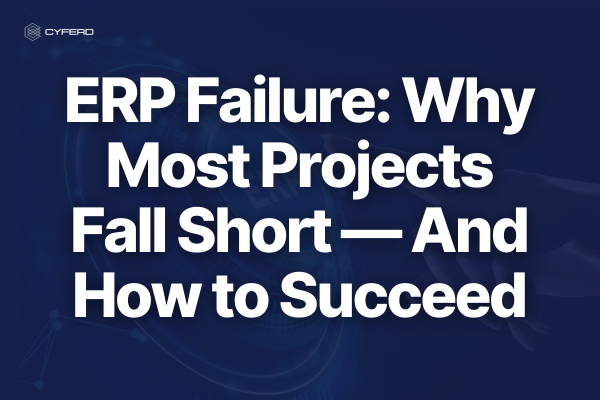Business

ERP Failure: Why Most Projects Fall Short — And How to Succeed
Introduction: The Reality of ERP Success
Enterprise Resource Planning (ERP) systems are often sold as a magic solution for streamlining operations, connecting data, and enabling better decision-making. However, the reality is that many ERP projects don’t live up to expectations.
In fact, According to Gartner, over 70% of ERP implementations fail to meet their original business use case goals, but this doesn’t always equate to complete failure [1]. More often than not, the system falls short of its promise. This leads to higher costs, delays, disappointment and lower ROI than anticipated.
The Key issue isn’t always the software itself, it’s the strategy, alignment, and complexity surrounding the ERP initiative. ERP Isn’t just an IT task; it’s a business transformation. And just as every business has unique needs, so too does every ERP project require its own tailored approach.
Why ERP Projects Fall Short
Requirements Gathering – More Than a Checklist
Automating chaos only leads to more chaos, contributing to ERP failure.
Requirements gathering is often treated as a formality—but it’s one of the most critical steps in ERP implementation. When rushed, it leads to automating broken processes, unexpected cost overruns, and ultimately, a system that fails to deliver what the business actually needs.
The Risks of ERP Failure:
- Misaligned functionality
- Unnecessary complexity
- Timeline delays and budget creep
The Rewards of Doing It Right:
- Alignment with strategic business goals
- Buy-in from stakeholders across departments
- Easier, more accurate configuration
- Lower costs and fewer surprises
Best Practices to Avoid ERP Failure:
- Define SMART goals (Specific, Measurable, Achievable, Relevant, Time-bound)
- Conduct a process audit: map out what’s working—and what isn’t
- Prioritize functionality based on business outcomes
- Involve every relevant department early
- Use a blended approach: combine solution-driven, requirements-driven, and configuration-driven strategies for a full view. [2]
It’s Not the Software – It’s the Strategy
Too many organizations treat ERP implementations like a technical IT project. But ERP is a business transformation tool, and it requires far more than just technical execution to succeed.
One of the primary reasons why ERP projects fall short is a lack of strategic clarity. When executives and projects leaders don’t fully define the business case, establish clear goals, or align cross-functional teams, the project is at risk of derailing before it even begins.
Common issues behind ERP Strategy failures include:
- A weak or poorly communicated business case
- Inadequate business process design – automating inefficient processes without rethinking them
- Gaps in executive sponsorship and leadership alignment
- Lack of organizational change management – a failure to prepare people, roles and culture for the shift
- Disconnect between technical teams and operational goals [3]
A Strategic ERP Roadmap Should Include:
• A compelling business case clearly tied to strategic objectives
• A phased, realistic timeline with milestones
• Budget guardrails and full cost visibility
• Clearly defined roles, responsibilities, and accountability across all departments
• Redesigned, optimized business processes to support the new system
• Robust change management plans to guide people through the transformation
• Integration plans that consider both current systems and future scalability
ERP Complexity: A Challenge You Can’t Ignore
ERP systems are powerful because they embed decades of operational best practices into their modules. Finance, HR, supply chain, manufacturing—each ERP provider designs modules around these industry-tested models to ensure operational efficiency.
However, complexity arises when companies customize their ERP systems too heavily. When you try to modify an ERP beyond its original design, you run into significant challenges:
- Increased costs: ERP specialists are costly, and customizing a system requires specialized expertise that can add significant cost to the project.
- Slower upgrades and harder maintenance: Custom ERP systems become more difficult and expensive to update or scale, resulting in longer timelines and higher maintenance costs.
- System fragility: Over-customized ERPs are often fragile and difficult to adapt to future business needs.
Here’s the catch:
ERP systems work best when used as designed, leveraging industry best practices that have already been embedded into the system. Over-customization creates unnecessary complexity and compromises the value of the system.

The Hidden Cost of Over-Customization
Many organizations buy ERP systems with the goal of leveraging the best practices already baked into the software. However, the reality is that these systems are often over-customized in an attempt to align with outdated business processes or specific preferences.
This can lead to:
- Budget overruns: Over-customization often results in unforeseen costs, especially as you hire specialized consultants or invest in additional tools.
- Missed timelines: Every customization adds complexity, and ERP projects become delayed as the scope of work increases.
- Higher risk: A customized ERP system is harder to maintain, upgrade, or scale over time, making it more prone to issues as your business evolves.
Instead of trying to force the ERP to match your existing processes, it’s smarter to leverage the ERP’s best practices and augment it with external systems or customizations where necessary. The more you try to mold the ERP to your needs, the more you’re likely to derail the project.
A Better Way Forward: Augment and Abstract
Here’s the key to a successful ERP implementation: don’t break your ERP system. Augment it.
Rather than over-customizing the ERP or trying to force it to match every specific need, the smarter solution is to abstract custom business workflows and needs outside the ERP system. This means:
- Preserving ERP best practices: Keep the core of the ERP system intact, relying on its established workflows and processes.
- Building business-specific processes around the ERP: For unique workflows, create external systems that integrate with the ERP, rather than modifying the ERP itself.
- Allowing flexibility for change: As your business evolves, your external systems can change without impacting the core ERP functionality.
Cyferd helps businesses achieve this balance. Cyferd offers a flexible platform that enhances the value of your ERP by abstracting and augmenting functionality rather than over-customizing the ERP.
With Cyferd, you can:
- Customize your business processes without disrupting the ERP core.
- Adapt as your business evolves, without facing the challenges of costly ERP changes.
- Leverage real-time data and insights across your ERP and business-specific systems.
Strategic Alignment is Still the True Success Factor
At the heart of every successful ERP project is strategic alignment. Regardless of whether you’re using an off-the-shelf ERP system or augmenting it with platforms like Cyferd, the business case, clarity, and alignment across teams are the true success factors.
Here’s how to ensure strategic alignment:
- Define clear goals: Establish measurable, specific, and realistic goals for your ERP project that align with broader business objectives.
- Engage leadership: Ensure full executive buy-in to guarantee the success of the project across all departments.
- Involve end users from day one: Operational users must be engaged early in the process to ensure the system matches their needs and gets buy-in.
An ERP system is a powerful tool—but only if it’s used to support your strategy. By embedding strategic thinking into the implementation process, you can drive both operational efficiency and business transformation.

Rethinking ERP with Cyferd
ERP success = strategic clarity + stakeholder alignment + continuous optimization.
Cyferd redefines what an ERP solution can be—not a one-size-fits-all system, but a dynamic, business-first platform that adapts to your goals, not the other way around.
Control: Build systems around your business, not someone else’s template
You know your business best. With Cyferd, you’re not locked into rigid templates or forced to mold your operations around outdated processes. You define your workflows, your structures, and your logic from day one. That means faster decision-making, more relevant tools, and the ability to evolve without disruption.
Clarity: See what’s happening in real time
Traditional ERPs often operate on lagging indicators. By the time you see the reports, the opportunity has passed. Cyferd delivers real-time insights powered by intelligent data modeling, giving you a complete view of your business as it unfolds. Your teams can act faster, adapt sooner, and make decisions with full confidence.
Flexibility: Change is constant. Your systems should be, too.
As your organization grows, restructures, or pivots, Cyferd evolves with you. Update processes, modify data models, and roll out new capabilities, without starting from scratch. Your ERP becomes a living part of your business, not a legacy system waiting to break.
Speed: Innovate faster without the bottlenecks
Long dev cycles. Endless change requests. External dependencies. These are the delays that slow innovation to a crawl. Cyferd eliminates that drag by making your systems instantly adaptable. Move from idea to execution in days, not quarters. Launch new initiatives with agility and scale with ease.
Final Thought: ERP Success Starts Before You Buy
Too many businesses fall into the trap of thinking ERP is just an IT decision. It’s not. It’s a business transformation and the stakes are high.
The difference between failure and success isn’t the software.
It’s clarity of purpose, alignment across teams, and a platform built to evolve with you.
That’s where Cyferd comes in.
References:
[1] Gartner -Enterprise Resource Planning to Optimize Operations – https://www.gartner.com/en/information-technology/topics/enterprise-resource-planning
[2] Wheelhouse – What is the Best Approach for Gathering ERP Requirements? – https://www.wheelhouse.com/resources/what-is-the-best-approach-for-gathering-erp-requirements-a8999
[3] Pemeco – Two Big Reasons Why ERP Implementations Have Failure Rates Higher than 50% – https://pemeco.com/two-big-reasons-erp-implementation-failure/
Find out more About Cyferd
New York
Americas Tower
1177 6th Avenue
5th Floor
New York
NY 10036
London
2nd Floor,
Berkeley Square House,
Berkeley Square,
London W1J 6BD
